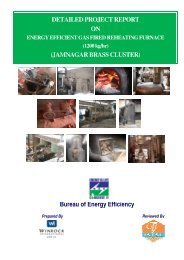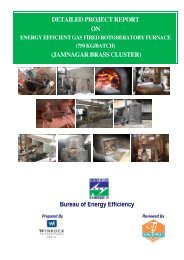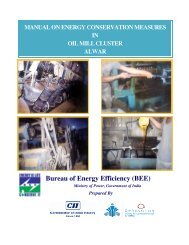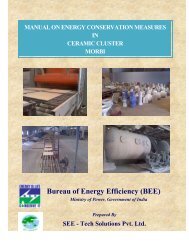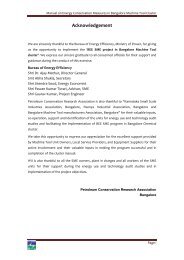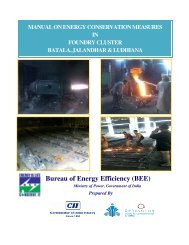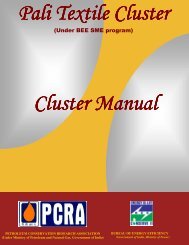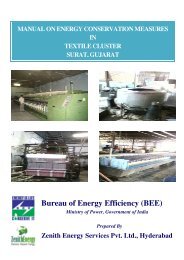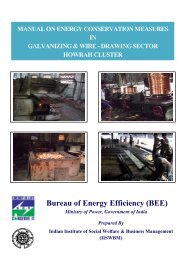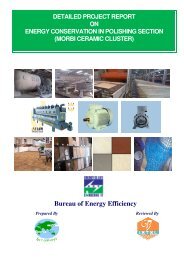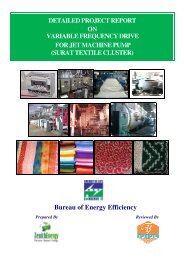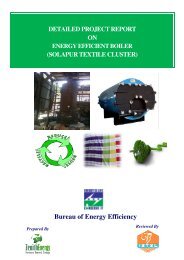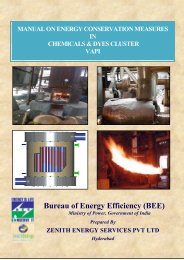MORBI CERAMIC CLUSTER - Sameeeksha
MORBI CERAMIC CLUSTER - Sameeeksha
MORBI CERAMIC CLUSTER - Sameeeksha
Create successful ePaper yourself
Turn your PDF publications into a flip-book with our unique Google optimized e-Paper software.
DETAILED PROJECT REPORT<br />
ON<br />
GAS TURBINE BASED<br />
CO-GENERATION TECHNOLOGY<br />
(<strong>MORBI</strong> <strong>CERAMIC</strong> <strong>CLUSTER</strong>)<br />
Prepared By<br />
Bureau of Energy Efficiency<br />
Reviewed By
GAS TURBINE BASED<br />
CO-GENERATION TECHNOLOGY<br />
<strong>MORBI</strong> <strong>CERAMIC</strong> <strong>CLUSTER</strong>
For more information<br />
BEE, 2010<br />
Detailed Project Report on Gas Turbine Based Co-generation Technology<br />
(3.5 MW)<br />
Ceramic SME Cluster, Morbi, Gujarat (India)<br />
New Delhi: Bureau of Energy Efficiency;<br />
Detail Project Report No.: MRV/CRM/GTG/09<br />
Bureau of Energy Efficiency (BEE) Telephone +91-11-26179699<br />
(Ministry of Power, Government of India) Fax +91-11-26178352<br />
4 th Floor, Sewa Bhawan Websites: www.bee-india.nic.in<br />
R. K. Puram, New Delhi – 110066 Email: jsood@beenet.in/ pktiwari@beenet.in
Acknowledgement<br />
We sincerely appreciate the efforts of industry, energy auditors, equipment manufacturers,<br />
technology providers, consultants and other experts in the area of energy conservation for<br />
joining hands with Bureau of Energy Efficiency (BEE), Ministry of Power, and Government of<br />
India for preparing the Detailed Project Report (DPR) under BEE SME Program in SMEs<br />
clusters. We appreciate the support of suppliers/vendors for providing the adoptable energy<br />
efficient equipments/technical details to the SMEs.<br />
We have received very encouraging feedback for the BEE SME Program in various SME<br />
Clusters. Therefore, it was decided to bring out the DPR for the benefits of SMEs. We<br />
sincerely thank the officials of BEE, Executing Agencies and ISTSL for all the support and<br />
cooperation extended for preparation of the DPR. We gracefully acknowledge the diligent<br />
efforts and commitments of all those who have contributed in preparation of the DPR.
Contents<br />
List of Annexure vii<br />
List of Tables vii<br />
List of Figures viii<br />
List of Abbreviation viii<br />
Executive summary ix<br />
About BEE’S SME program xii<br />
1 INTRODUCTION........................................................................................................... 1<br />
1.1 Brief Introduction about cluster ...................................................................................... 1<br />
1.2 Energy performance in existing system ......................................................................... 6<br />
1.2.1 Fuel consumption .......................................................................................................... 6<br />
1.2.2 Average annual production ........................................................................................... 6<br />
1.2.3 Specific energy consumption ........................................................................................ 7<br />
1.3 Existing technology/equipment ...................................................................................... 8<br />
1.3.1 Description of existing technology ................................................................................. 8<br />
1.3.2 Role in process ........................................................................................................... 10<br />
1.4 Baseline establishment for existing technology ........................................................... 10<br />
1.4.1 Design and operating parameters ............................................................................... 10<br />
1.4.2 Operating efficiency analysis ....................................................................................... 11<br />
1.5 Barriers in adoption of proposed equipment ................................................................ 11<br />
1.5.1 Technological barrier ................................................................................................... 11<br />
1.5.2 Financial barrier .......................................................................................................... 12<br />
1.5.3 Skilled manpower ........................................................................................................ 12<br />
1.5.4 Other barrier (If any) .................................................................................................... 12<br />
2. PROPOSED EQUIPMENT FOR ENERGY EFFICENCY IMPROVEMENT ................. 13<br />
2.1 Description of proposed equipment ............................................................................. 13<br />
2.1.1 Detailed of proposed equipment .................................................................................. 13
2.1.2 Equipment/technology specification ............................................................................ 13<br />
2.1.3 Integration with existing equipment ............................................................................. 14<br />
2.1.4 Superiority over existing system .................................................................................. 15<br />
2.1.5 Source of equipment ................................................................................................... 15<br />
2.1.6 Availability of technology/equipment ........................................................................... 15<br />
2.1.7 Service providers ........................................................................................................ 15<br />
2.1.8 Terms and conditions in sales of equipment................................................................ 15<br />
2.1.9 Process down time ...................................................................................................... 16<br />
2.2 Life cycle assessment and risks analysis .................................................................... 16<br />
2.3 Suitable unit for Implementation of proposed technology ............................................ 16<br />
3. ECONOMIC BENEFITS FROM PROPOSED TECHNOLOGY .................................... 17<br />
3.1 Technical benefit ......................................................................................................... 17<br />
3.1.1 Fuel saving.................................................................................................................. 17<br />
3.1.2 Electricity saving ......................................................................................................... 17<br />
3.1.3 Improvement in product quality ................................................................................... 17<br />
3.1.4 Increase in production ................................................................................................. 17<br />
3.1.5 Reduction in raw material ............................................................................................ 17<br />
3.1.6 Reduction in other losses ............................................................................................ 17<br />
3.2 Monetary benefits........................................................................................................ 18<br />
3.3 Social benefits ............................................................................................................. 18<br />
3.3.1 Improvement in working environment .......................................................................... 18<br />
3.3.2 Improvement in workers skill ....................................................................................... 18<br />
3.4 Environmental benefits ................................................................................................ 19<br />
3.4.1 Reduction in effluent generation .................................................................................. 19<br />
3.4.2 Reduction in GHG emission ........................................................................................ 19<br />
3.4.3 Reduction in other emissions like SOX ........................................................................ 19<br />
4 INSTALLATION OF PROPOSED EQUIPMENT ......................................................... 20
4.1 Cost of project ............................................................................................................. 20<br />
4.1.1 Equipment cost ........................................................................................................... 20<br />
4.1.2 Erection, commissioning and other misc. cost ............................................................. 20<br />
4.2 Arrangements of funds ................................................................................................ 20<br />
4.2.1 Entrepreneur’s contribution ......................................................................................... 20<br />
4.2.2 Loan amount. .............................................................................................................. 21<br />
4.2.3 Subsidy by Government .............................................................................................. 21<br />
4.2.4 Terms & conditions of loan .......................................................................................... 21<br />
4.3 Financial indicators ..................................................................................................... 21<br />
4.3.1 Cash flow analysis ...................................................................................................... 21<br />
4.3.2 Simple payback period ................................................................................................ 21<br />
4.3.3 Net Present Value (NPV) ............................................................................................ 22<br />
4.3.4 Internal rate of return (IRR) ......................................................................................... 22<br />
4.3.5 Return on investment (ROI) ........................................................................................ 22<br />
4.4 Sensitivity analysis ...................................................................................................... 22<br />
4.5 Procurement and implementation schedule................................................................. 23
List of Annexure<br />
Annexure -1: Energy audit data used for baseline establishment ......................................... 24<br />
Annexure -2: Process flow diagram after project implementation ......................................... 26<br />
Annexure -3: Detailed technology assessment report .......................................................... 27<br />
Annexure -4 Drawings for proposed electrical & civil works ................................................ 28<br />
Annexure -5: Detailed financial analysis ............................................................................... 29<br />
Annexure:-6 Procurement and implementation schedule .................................................... 33<br />
Annexure -7: Details of technology service providers ........................................................... 34<br />
Annexure -8: Quotations or Techno-commercial bids for new technology/equipment ........... 35<br />
List of Table<br />
Table 1.1 Details of annual energy consumption ....................................................................... 1<br />
Table 1.2 Details of types of product manufactured ................................................................... 2<br />
Table 1.3 Production wise unit breakups ................................................................................... 2<br />
Table 1.4 Average fuel and electricity consumption ................................................................... 6<br />
Table 1.5 Average annual production ........................................................................................ 6<br />
Table 1.6 Specific energy consumption ..................................................................................... 7<br />
Table 1.7 Equipment wise specific energy consumption ............................................................ 7<br />
Table 1.8 Spray dryer specifications .......................................................................................... 8<br />
Table 1.9 Energy charges ......................................................................................................... 9<br />
Table 1.10 Demand charge ....................................................................................................... 9<br />
Table 1.11 Natural gas and electricity consumption ................................................................. 10<br />
Table 1.12 Operating efficiency analysis for different fuel ........................................................ 11<br />
Table 2.1 Technical specification of Gas turbine ..................................................................... 13<br />
Table 2.2 Detail design of piping and ducting system .............................................................. 14<br />
Table 3.1 Energy and monetary benefit ................................................................................... 18<br />
Table 4.1 Details of proposed technology project cost ............................................................. 20<br />
vii
Table 4.2 Financial indicators of proposed technology/equipment ........................................... 22<br />
Table 4.3 Sensitivity analysis at different scenarios ................................................................. 23<br />
Table 4.4 Procurement and implementation schedule ............................................................. 23<br />
List of Figures<br />
Figure 1.1 Process flow diagram ............................................................................................... 5<br />
List of Abbreviation<br />
BEE Bureau of Energy Efficiency<br />
SME Small and Medium Enterprises<br />
DPR Detailed Project Report<br />
GHG Green House Gases<br />
CDM Clean Development Mechanism<br />
DSCR Debt Service Coverage Ratio<br />
NPV Net Present Value<br />
IRR Internal Rate of Return<br />
ROI Return on Investment<br />
WHR Waste Heat Recovery<br />
SCM Standard Cubic Meter<br />
GT Gas Turbine<br />
MW Mega Watt<br />
GWh Giga Watt Hours<br />
SIDBI Small Industrial Development Bank of India<br />
MT Million Tonne<br />
viii
EXECUTIVE SUMMARY<br />
SEE-Tech Solution Pvt. Ltd. is executing BEE-SME program in Morbi Ceramic Cluster,<br />
supported by Bureau of Energy Efficiency (BEE) with an overall objective of improving the<br />
energy efficiency in cluster units.<br />
Morbi cluster is one of the largest ceramic clusters in India; accordingly this cluster was<br />
chosen for energy efficiency improvements by implementing energy efficient<br />
measures/technologies, so as to facilitate maximum replication in other ceramic clusters in<br />
India. The main energy forms used in the cluster units are grid electricity, Natural gas,<br />
charcoal, lignite and small quantity of diesel oil.<br />
In ceramic industry 50% of total energy is consumed in spray dryer. Spray dryer is used to<br />
remove the moisture present in the raw material which is added during the grinding process.<br />
Slurry containing 35-37% moisture and remaining 63-65% clay is dried to about 4-5%<br />
moisture in a spray dryer. Majority of the ceramic units of the cluster uses solid fuel in spray<br />
dryer whereas very few units use Natural gas.<br />
This DPR highlights the energy, environment, economic and social benefits of use of Gas<br />
turbine based co-generation technology for power generation and utilization of waste heat<br />
from turbine in spray dryer. Gas turbine based co-generation technology, generates electrical<br />
energy and thermal energy at the same time by using Natural gas as a fuel. Further this<br />
thermal energy used in spray dryer for removing moisture present in raw material. For<br />
implementing this technology vitrified tiles unit has been selected, where the Natural gas is<br />
used as a fuel in spray dryer. Exhaust of gas turbine will be available at a temperature of<br />
about 500 to 550 o C which will fulfill the heat requirement of spray dryer.<br />
Total investment required and financial indicators calculated such as debt equity ratio, monetary<br />
saving, IRR, NPV, DSCR and ROI etc for proposed technology is furnished in Table below:<br />
S.No Particular Unit Value<br />
1 Project cost `(in Lakh) 1904<br />
2 Fuel Saving due to utilization of waste heat SCM/year 9,015,551<br />
3 Electricity generated by Gas turbine GWh/year 23.06<br />
4 Natural gas consumption in Gas Turbine SCM/year 11,880,000<br />
3 Monetary benefit `(in Lakh) 527.45<br />
4 Debit equity ratio Ratio 3:1<br />
5 Simple payback period year 3.6<br />
ix
S.No Particular Unit Value<br />
6 NPV `(in Lakh) 351.67<br />
7 IRR %age 16.70<br />
8 ROI %age 20.76<br />
9 DSCR Ratio 1.36<br />
10 Process down time Days 10<br />
The projected profitability and cash flow statements indicate that the project implementation<br />
i.e. installation of Gas turbine based cogeneration technology will be financially viable and<br />
technically feasible solution for ceramic cluster.<br />
x
ABOUT BEE’S SME PROGRAM<br />
Bureau of Energy Efficiency (BEE) is implementing a BEE-SME Programme to improve the<br />
energy performance in 25 selected SMEs clusters. Morbi Ceramic Cluster is one of them. The<br />
BEE’s SME Programme intends to enhance the energy efficiency awareness by<br />
funding/subsidizing need based studies in SME clusters and giving energy conservation<br />
recommendations. For addressing the specific problems of these SMEs and enhancing<br />
energy efficiency in the clusters, BEE will be focusing on energy efficiency, energy<br />
conservation and technology up-gradation through studies and pilot projects in these SMEs<br />
clusters.<br />
Major activities in the BEE -SME program are furnished below:<br />
Energy use and technology audit<br />
The energy use technology studies would provide information on technology status, best<br />
operating practices, gaps in skills and knowledge on energy conservation opportunities,<br />
energy saving potential and new energy efficient technologies, etc for each of the sub sector<br />
in SMEs.<br />
Capacity building of stake holders in cluster on energy efficiency<br />
In most of the cases SME entrepreneurs are dependent on the locally available technologies,<br />
service providers for various reasons. To address this issue BEE has also undertaken<br />
capacity building of local service providers and entrepreneurs/ Managers of SMEs on energy<br />
efficiency improvement in their units as well as clusters. The local service providers will be<br />
trained in order to be able to provide the local services in setting up of energy efficiency<br />
projects in the clusters<br />
Implementation of energy efficiency measures<br />
To implement the technology up-gradation project in the clusters, BEE has proposed to<br />
prepare the technology based detailed project reports (DPRs) for a minimum of five<br />
technologies in three capacities for each technology.<br />
Facilitation of innovative financing mechanisms for implementation of energy<br />
efficiency projects<br />
The objective of this activity is to facilitate the uptake of energy efficiency measures through<br />
innovative financing mechanisms without creating market distortion<br />
xi
1 INTRODUCTION<br />
1.1 Brief Introduction about cluster<br />
Gas Turbine Based Co-generation Technology<br />
Morbi SME Cluster is one of the largest ceramic clusters in India and mainly famous for<br />
manufacturing of ceramic tiles. Over 70% of total ceramic tiles product comes from Morbi<br />
cluster. This cluster is spread over a stretch of about 10km on the Morbi–Dhuva Highway.<br />
There are approximately 479 ceramic units in this cluster which are engaged in manufacturing<br />
of wall tiles, vitrified tiles, floor tiles, sanitary wares, roofing tiles and others product. There are<br />
around 50 more ceramic units coming up in Morbi cluster.<br />
Primary raw materials required for manufacturing of tiles are various types of clay, quartz,<br />
calcite/wool astonite, frits & Glazes. Most of the raw materials are easily available in Gujarat<br />
and in the neighboring state of Rajasthan. Some of the units use raw material produced at<br />
another plant. The main reason for growth of ceramic cluster in Morbi is easy availability of<br />
raw material viz; clay suitable for ceramic tiles.<br />
The main form of energy used by the cluster units are grid electricity, Natural Gas, charcoal,<br />
lignite, and diesel oil. Major consumptions of energy are in the form of Natural Gas and lignite.<br />
Details of total energy consumption at Morbi ceramic cluster are furnished in Table 1.1 below:<br />
Table 1.1 Details of annual energy consumption<br />
S. No Type of Fuel Unit Value % contribution<br />
1 Electricity GWh/year 1,200 8.23<br />
2 Natural Gas SCM/year 660,000,000 46.32<br />
3 Charcoal tonne/year 165,000 8.55<br />
4 Lignite tonne/year 1,320,000 36.84<br />
5 Diesel litre/year 800,000 0.06<br />
Classification of Units<br />
The ceramic units can be broadly categorized into four types based on product manufactured<br />
• Floor tiles unit<br />
• Sanitary ware unit<br />
• Vitrified tiles unit<br />
• Wall tiles unit<br />
1
Gas Turbine Based Co-generation Technology<br />
Further the ceramic cluster is classified into three type based on capacity of unit viz small scale,<br />
medium scale and large scale unit.<br />
Products Manufactured<br />
There are many types of ceramic product manufactured from four different types of units.<br />
Details of product manufactured and number of units engaged in manufacturing of such<br />
products are given in Table 1.2 below:<br />
Table 1.2 Details of types of product manufactured<br />
S. No Type of Product No. of unit %age share<br />
1 Wall Tiles 178 37<br />
2 Vitrified Tiles 36 8<br />
3 Floor Tiles 52 11<br />
4 Sanitary Wares 43 9<br />
5 Spray dryer Mud manufacturing 40 8<br />
6 Roofing Tiles (seasonal operation) 120 25<br />
7 Third firing manufacturing (Producing pictures on tiles) 10 2<br />
8 Total 479<br />
Capacity wise production<br />
Capacity wise production breakup is furnished in Table 1.3 below:<br />
Table 1.3 Production wise unit breakups<br />
Type of<br />
product<br />
No. of Units. Production (m 2 /day or MT a /day)<br />
Scale of Unit Small Medium Large Total Small Medium Large Total<br />
Wall Tiles 43 100 35 178 2,500 3,500 7,500 13,500<br />
Floor Tiles 8 38 6 52 3,000 4,000 7,000 14,000<br />
Vitrified Tiles NA 22 4 26 b NA 5,760 11,520 17,280<br />
Sanitary Wares 10 24 9 43 4 8 14 26<br />
a- In case of sanitary wares, production is measured in MT,. b- During audit no SSI vitrified tiles units were<br />
covered, therefore production data are not available for these units.<br />
2
Energy usages pattern<br />
Gas Turbine Based Co-generation Technology<br />
Average monthly electricity consumption in ceramic unit ranges from 1 lakh to 2 lakh kWh<br />
depending on the size of the unit. In thermal energy, solid fuel such as lignite, charcoal,<br />
Indonesian coal, briquette, etc are used in spray dryer and natural Gas is used in kiln in all<br />
almost all units. Solid fuel consumption in spray dryer ranges from 80 to 160 kg/MT and. natural<br />
Gas consumption in kiln varies from 1.01 to 1.4 SCM/m 2 of tiles produced.<br />
General production process for ceramic cluster<br />
The units of Morbi ceramic cluster are involved in the manufacturing of 4 different types of<br />
products such as floor tiles, wall tiles, vitrified tiles and sanitary wares. Production process for<br />
manufacture of wall, floor and vitrified tiles is nearly the same except some differences in<br />
process parameters while the manufacturing process of sanitary wares inter alia involves<br />
manual moulding whereas in case of tiles, press is used to form the biscuits. General production<br />
processes for manufacturing of ceramic products is are following:<br />
Wet Grinding<br />
The raw material such as clay, feldspar, quartz, calcite etc. are mixed with water in a proper<br />
proportion and grind in a ball mill to make homogeneous mixture. Ball Mill is a batch type of<br />
process. After completion of one batch of ball mill, slurry is sent to the underground tanks<br />
containing the agitator motor in each tank to maintain the uniformity of mixture. Mainly blungers<br />
are used for mixing and grinding in case of wall and floor tiles, while ball mills are used for<br />
grinding in case of vitrified tiles.<br />
Spray Drying<br />
After preparation of slurry of required density it is stored in the underground tanks in which it is<br />
agitated to maintain uniformity of slurry. The slurry is then pumped through a hydraulic pump<br />
into the spray dryer where it is sprayed through nozzles. The material is dried in spray dryer to<br />
remove the moisture added during the grinding process in a ball mill. The moisture in the raw<br />
material is brought down to about 5–6 % from 35-40%. The product from spray dryer is stored in<br />
silos. Hot flue gases at a temperature of about 550 – 600 o C is used as the heating source<br />
which is generated by combustion of lignite, Indonesian coal, saw dust, briquette, natural gas<br />
etc.<br />
3
Pressing/Moulding<br />
Gas Turbine Based Co-generation Technology<br />
The product from spray dryer is then sent to the press section which is pneumatically operated<br />
where the required sizes of biscuit tiles are formed. In case of sanitary ware manual moulding is<br />
carried out by hand held hose.<br />
Drying<br />
After pressing/moulding products containing about 5–6% moisture is dried to about 2–3%<br />
moisture in a dryer. In some units, hot air from kiln cooling zone exhaust is used in dryers and<br />
additional fuel firing is provided if required whereas in case of wall and floor tiles, fuel firing is<br />
done continuously.<br />
Glazing<br />
After drying, biscuit tiles are send for glazing on a glaze line. Glaze is prepared in ball mills.<br />
Glazing is required for designing on tiles. In case of sanitary ware the dried wares are glazed in<br />
several spray glazing booths, where compressed air is used.<br />
Firing and Baking<br />
After glazing product are then sent for final firing in kiln where temperature of 1100-1150 o C is<br />
maintained in the kiln. Natural gas is used for combustion in kiln. In some units hot air from<br />
gasifier is utilized for combustion.<br />
Sizing<br />
Tiles coming out of kiln are sent for sizing and calibration in case of wall and floor tiles. The tiles<br />
are cut in proper sizes so that all tiles have similar dimensions. After sizing the finished product<br />
is ready for dispatch.<br />
Polishing<br />
Polishing is required for vitrified tiles. It utilizes 40-45% of total electricity consumption of plant.<br />
After kiln the vitrified tiles are passed through polishing line. Polishing line consist of sizing,<br />
calibration and polishing machines.<br />
General production process flow diagram for manufacturing of ceramic product is shown in<br />
Figure 1.1.<br />
4
Water<br />
Fuel such as<br />
Lignite, NG etc<br />
Compressed Air<br />
NG (Optional)<br />
Water in Glaze room and<br />
compressed air in glaze line<br />
Fuel such as NG,<br />
Coal, Briquette etc<br />
Figure 1.1 Process flow diagram<br />
Gas Turbine Based Co-generation Technology<br />
Raw Material<br />
Ball Mill/ Blunger<br />
Agitation Tanks<br />
Spray Dryer<br />
Dryer<br />
Glaze Line &<br />
Glaze Room<br />
Kiln<br />
Polishing/Sizing<br />
Finished Product<br />
Electricity<br />
Electricity<br />
Electricity<br />
Press/Moulding Electricit<br />
Electricity<br />
Electricity<br />
Electricity<br />
Electricity<br />
5
1.2 Energy performance in existing system<br />
1.2.1 Fuel consumption<br />
Gas Turbine Based Co-generation Technology<br />
Average fuel and electricity consumption in a typical ceramic unit is given in Table 1.4 below:<br />
Table 1.4 Average fuel and electricity consumption<br />
Energy<br />
Scale of<br />
Unit<br />
Electricity<br />
(MWh per year)<br />
1.2.2 Average annual production<br />
Annual production in terms of m 2 /year is taken in case of tiles and in terms of MT/year in case of<br />
sanitary wares is given in the following Table 1.5 below:<br />
Table 1.5 Average annual production<br />
Natural gas<br />
(SCM per year)<br />
Solid Fuel [lignite]<br />
(Tonne per year)<br />
Small Medium Large Small Medium Large Small Medium Large<br />
Wall Tiles 900 1500 2400 750,000 1,050,000 2,250,000 2,400 2,880 3,600<br />
Floor<br />
Tiles<br />
Vitrified<br />
Tiles<br />
Sanitary<br />
Wares<br />
900 1500 2400 900,000 1,200,000 2,100,000 3,600 4,200 4,800<br />
NA 6000 12000 NA 2,700,000 6,000,000 NA 6,000 9,000<br />
2400 450 900 120,000 240,000 420,000 NA NA NA<br />
S. No. Type of Industry<br />
Production (m 2 /year) or MT/year<br />
Small scale Medium scale Large scale<br />
1 Vitrified Tiles 750,000 1,050,000 2,250,000<br />
2 Wall Tiles 900,000 1,200,000 2,100,000<br />
3 Floor Tiles NA 1,728,000 3,456,000<br />
4 Sanitary Wares 1200 2400 4200<br />
6
1.2.3 Specific energy consumption<br />
Gas Turbine Based Co-generation Technology<br />
Specific energy consumption both electrical and thermal energy per m 2 or MT of production for<br />
different type of ceramic products are furnished in Table 1.6below:<br />
Table 1.6 Specific energy consumption<br />
S. No. Type of Industry<br />
Equipment wise specific energy consumption<br />
The specific energy consumption of the equipments used in the ceramic industry is given in<br />
Table 1.7 below wherever possible.<br />
Table 1.7 Equipment wise specific energy consumption<br />
C In sanitary ware production is measured in term of pieces only.<br />
kWh/m 2 or<br />
kWh/piece<br />
SCM/m 2 or<br />
SCM/piece<br />
1 Vitrified Tiles 3.71 - 5.01 1.51 - 3.11<br />
2 Wall Tiles 0.61 - 2.47 0.68 - 1.65<br />
3 Floor Tiles 1.51 - 1.92 1.28 - 1.8<br />
4 Sanitary Wares 0.78 - 1.73 1.10 - 1.49<br />
S.No Equipment<br />
Electrical energy Thermal energy<br />
Unit Vale Unit value<br />
1 Ball Mill/Blunger kWh/MT 4 -12 -<br />
2 Agitation process kWh/m 3 /hr 0.2 - 0.8 -<br />
3 Spray Dryer - - kg/MT 80 - 160<br />
4 Press kWh/m 2 0.22- 0.4 -<br />
5 Dryer kWh/m 2 0.011 SCM/m 2 0 - 0.63<br />
6 Glaze line + Glaze ball mill kWh/MT 2 - 9 -<br />
7 Kiln kWh/m 2 0.36 - 1.26 SCM/m 2 1.01 -1.4<br />
8 Polishing line/sizing kWh/m 2 1.74 - 2.35 -<br />
7
1.3 Existing technology/equipment<br />
1.3.1 Description of existing technology<br />
Gas Turbine Based Co-generation Technology<br />
In ceramic plant, electricity cost is about 25 to 30% of total cost and the natural gas<br />
consumption cost in spray dryer is about 35 to 40% of total energy consumption cost in a unit.<br />
Hence, about 60 to 70% of total energy cost in ceramic plant is in the spray dryer only.<br />
Spray dryer is used to remove the moisture present in raw material which was added during the<br />
grinding process. Flue gas generated after combustion of natural gas is cooled upto a<br />
temperature of about 55 O C with the addition of air by another blower and then sent to the spray<br />
dryer as a heat source to evaporate the moisture present in the raw material. It is a direct<br />
contact type of drying where the flue gas is in direct contact with the raw material.<br />
Existing Spray Dryer Specification is shown in Table 1.8 below.<br />
Table 1.8 Spray dryer specifications<br />
Components Different parts Detail<br />
Burners Natural gas fired<br />
Atomizer<br />
Chambers<br />
Product separation<br />
Controls safety<br />
Capacities<br />
Rotary disc<br />
Wheel dia:100mm to 350mm<br />
Pressure nozzle Low, high pressure<br />
Two fluid nozzle Air atomizing<br />
Wheel type: with parts in SS and ceramic<br />
Flat roof With and without bustle<br />
Tall from With and without bustle<br />
Tall from With second stage fluid bed<br />
Cyclone bag filter<br />
Bag filter self cleaning Reserve pulse jet<br />
Feed<br />
Feed rate 24 MT/hr<br />
Single point, two points or multi point<br />
Low and high pressure drop reserve jet<br />
DCS, PLC, MICRO-PROCESSOR<br />
Product Powder, granules.<br />
Explosion vents, pressure release flaps, fire<br />
quenching nozzles.<br />
Clear solution with slurries with 67% solid<br />
concentration<br />
8
Gas Turbine Based Co-generation Technology<br />
Components Different parts Detail<br />
Material of construction<br />
SS304, SS316, SS316, SS410, SS310,<br />
SS430, SS410.<br />
Fabrication Shop as well as site fabrication.<br />
At Morbi, electricity connection is taken from Paschim Gujarat Vitaran Company Limited at the<br />
following tariff rates<br />
Energy charges<br />
Table 1.9 Energy charges<br />
S. No. Contract Demand, KVA Energy Charges, Rs/KWh<br />
1 Upto 1000 3.85<br />
2 From 1001 to 2500 4.05<br />
3 Above 2500 4.15<br />
Demand Charges<br />
Table 1.10 Demand charge<br />
S. No. Billing Demand, KVA Demand Charges, Rs/KVA<br />
1 For first 500 98<br />
2 For next 500 139<br />
3 For next 1500 208<br />
4 Billing demand in Excess of 2500 237<br />
5 Billing Demand Excess of contract demand 369<br />
Therefore, total electricity Charges (including the maximum demand charges & other taxes) is<br />
Rs. 6.5 per kWh.<br />
9
1.3.2 Role in process<br />
Gas Turbine Based Co-generation Technology<br />
Basic purpose of spray dryer is to evaporate the water present in slurry. In ceramic industry,<br />
water is added in the raw material during the grinding process in Ball Mill / Blunger for proper<br />
mixing and grinding process in order to increase the fineness of the material.<br />
Cogeneration technology in ceramic plant will cater for electricity supply of plant utilities and<br />
thermal energy for spray dryer. Thus reducing the plant energy consumption cost.<br />
1.4 Baseline establishment for existing technology<br />
1.4.1 Design and operating parameters<br />
Natural gas consumption in spray dryer depends on the following parameters<br />
• Slurry flow rate to spray dryer<br />
• Moisture content in slurry<br />
• Temperature of slurry<br />
• Calorific value of fuel<br />
• Combustion air flow rate<br />
• Temperature of combustion air<br />
Electricity requirement in the ceramic plant depends on the production. Detail of Natural gas<br />
consumption in spray dryer and electricity comsumption in vitrified tites unit is given in Table<br />
1.11below:<br />
Table 1.11 Natural gas and electricity consumption<br />
S. No. Energy Type Unit<br />
1 Electricity kWh/year<br />
2 Natural Gas SCM/year<br />
Value<br />
Min Max<br />
1,066,7340 33,512,625<br />
3,100,385 7,602,808<br />
10
1.4.2 Operating efficiency analysis<br />
Gas Turbine Based Co-generation Technology<br />
Operating efficiency of the spray dryer is found to be in the range of 75 % to 83% for different<br />
types of fuels. Specific energy consumption in the spray dryer for different types of fuels is given<br />
in Table 1.12 below:<br />
Table 1.12 Operating efficiency analysis for different fuel<br />
S. No. Type of Fuel Unit Specific Fuel Consumption<br />
Min Max<br />
1 Natural Gas SCM/MT 32 36<br />
2 Charcoal kg/MT 57 60<br />
3 Saw Dust kg/MT 83 111<br />
4 Lignite kg/MT 109 122<br />
The operating efficiency of spray dryer is determined by indirect method. It includes the<br />
quantification of different types of losses occurred in spray dryer.<br />
Detailed parameters and calculations used for operating efficiency evaluation of spray dryer<br />
efficiency are given in the Annexure 1.<br />
1.5 Barriers in adoption of proposed equipment<br />
1.5.1 Technological barrier<br />
In Morbi cluster, overall technical understanding on ceramic manufacturing is good and rapidly<br />
increasing. Important equipments like kiln, polishing machine etc are bought from Italy (Sacmi)<br />
and China (Modena), which are leading suppliers of these equipments world wide. Many of the<br />
unit owners are frequently visiting international ceramic fairs and ceramic process equipment<br />
suppliers, thus keeping them informed. It has been observed that at cluster level there is<br />
committed interested for leadership and following up is quick. In general, there is readiness to<br />
adopt provided delivery, outcome and results are demonstrated.<br />
However the first change is still a challenge, upon success, later on duplication and adaptation<br />
is extremely prevalent in the cluster. The technologies need to be demonstrated within the<br />
cluster. While carrying out the audits and presenting the Energy audit reports to the units, in the<br />
discussion with the plant owners & other personnel, many of them agreed with many of the<br />
11
Gas Turbine Based Co-generation Technology<br />
identified energy saving measures and technologies but they demanded demonstration of the<br />
energy saving technologies in any plant and thereafter they have readiness to follow.<br />
1.5.2 Financial barrier<br />
Availing finance is not the major issue. Among the SMEs, the larger units, if convinced are<br />
capable of either financing it themselves or get the finance from their banks. The smaller units<br />
will require competitive loan and other support to raise the loan. However as most of them have<br />
been able to expand their setup and grow, there is readiness to spend for energy efficiency<br />
technologies which have good returns. Energy Efficiency Financing Schemes such as SIDBI’s, if<br />
focused on the cluster, will play a catalytic role in implementation of identified energy<br />
conservation projects & technologies.<br />
The cluster has significant potential of co-generation through gas turbine. However though there<br />
are good returns, this project is highly capital intensive and requires support of policy as well as<br />
innovative financial mechanisms. CDM needs to be duly applied to generate additional cash<br />
flow to further improve the returns from the project.<br />
1.5.3 Skilled manpower<br />
In Morbi ceramic cluster, the availability of skilled manpower is one of the problems due to more<br />
number of units. One local technical persons available at Morbi takes care of about 5-10<br />
ceramic units. Maintenance or repair work of major equipments of ceramic units like kiln,<br />
polishing machine etc, are generally taken care by the equipment suppliers itself as they station<br />
one of their experienced technical representative at Morbi for the maintenance work.<br />
Specialized and focused training of the local service providers on better operation and<br />
maintenance of the equipments, importance of the energy and its use and energy conservation<br />
measures will improve awareness among the unit owners and workforce. Original equipment<br />
suppliers should also participate in these programs.<br />
1.5.4 Other barrier (If any)<br />
Many of the new technology provider’s (especially some foreign technology leaders) have not<br />
shown keen interest in implementation of their new innovative technologies. This appears to be<br />
because of fear of duplication.<br />
.<br />
12
Gas Turbine Based Co-generation Technology<br />
2. PROPOSED EQUIPMENT FOR ENERGY EFFICENCY IMPROVEMENT<br />
2.1 Description of proposed equipment<br />
2.1.1 Detailed of proposed equipment<br />
Gas turbine based co-generation technology, generates electrical energy and thermal energy at<br />
the same time by using Natural gas as a fuel. Further this thermal energy used in spray dryer for<br />
removing moisture present in raw material. For implementing this technology vitrified tiles unit<br />
has been selected, where the Natural gas is used as a fuel in spray dryer. This is because of<br />
the following reasons.<br />
• Natural gas price is high as compared to the solid fuel.<br />
• In spray dryer, requirement of flue gas temperature is about 550 o C<br />
• Cogeneration technology helps to reduce the plant energy operating cost in terms of `<br />
per kCal in comparison with the present cost.<br />
Use of Gas Turbine for power generation and utilization of waste heat of turbine in spray dryer<br />
reduces total energy cost of plant. Exhaust of gas turbine is available at a temperature of about<br />
500 to 550 o C which can fulfill the heat requirement of spray dryer. If the requirement of spray<br />
dryer does not meet completely then the additional Natural gas firing is also there. In this<br />
project, the existing system does not get disturbed and keep it up as a back up for any<br />
emergency.<br />
For implementation of the proposed technology, separate system is provided without destroying<br />
the existing firing system of spray dryer and retrofits the same with the existing firing system.<br />
2.1.2 Equipment/technology specification<br />
Scince total electrical load of a typical vertifed unit is 2.8 MW hence a Gas turbine of capacity of<br />
about 3.5 MW will be required to install. Implementation of this project will include the following<br />
components like Gas turbine, sound enclosure, air supply system, control system and electrical<br />
system. Detail technical specification of Gas turnbine are furnished in Table 2.1 below:<br />
Table 2.1 Technical specification of Gas turbine<br />
S. No. Parameter Detail<br />
1 Manufacturer SOLAR<br />
2 Model Centaur 40 (T-4701)<br />
13
S. No. Parameter Detail<br />
3 Operation continuous<br />
Gas Turbine Based Co-generation Technology<br />
4 Turbine design open cycle, single shaft, cold-end drive<br />
5 Compressor 11 stages, axial<br />
6 Combustion chamber annular with 10 injectors<br />
7 Turbine 3 stage, axial-reaction<br />
8 Turbine speed 14 951 rpm<br />
9 Nominal shaft power rating 3 712 kW<br />
10 Heat input 12 611 kJ/s<br />
11 Weight approx. 3 200 kg<br />
Further detail techinacal and other specification of Gas turbine are shown in Annexure 8.<br />
Details of piping and ducting system for waste heat recovery are shown in Table 2.2 below:<br />
Table 2.2 Detail design of piping and ducting system<br />
S. No. Parameter Detail<br />
1 Duct Material MS<br />
2 Diameter of duct 762 mm<br />
3 Insulation Material Glass Wool<br />
4 Insulation thickness 75 mm<br />
5 Aluminum cladding 22 g<br />
6 Length of pipe Decided on the basis of site and location<br />
2.1.3 Integration with existing equipment<br />
Gas Turbine based cogeneration technology generates electricity for the plant where as the hot<br />
exhaust of the gas turbine is used in spray dryer. Mostly there is no supplementary fuel<br />
14
Gas Turbine Based Co-generation Technology<br />
requirement in the spray dryer. This saves total spray dryer fuel cost. Over all energy cost of<br />
plant in co-generation mode is lower than the present scenario. From total natural gas input to<br />
the gas turbine 19 % of the energy in Natural gas is converted to electricity, 5% of the energy<br />
considered as heat loss and remaining energy i.e.76% goes in flue gas which is supplied to the<br />
spray dryer through piping and ducting system.<br />
The following are the reasons for selection of this technology<br />
• Spray dryer is one of the major thermal energy consumers in ceramic industry<br />
• It will reduce the total operating energy cost of the plant.<br />
• It reduces the GHG emissions<br />
• This project is also applicable for getting the carbon credit benefits.<br />
• It is a clean technology.<br />
2.1.4 Superiority over existing system<br />
Use of this technology reduces the overall plant energy cost. It also eliminates the dependency<br />
for electricity on the state electricity grid. As the Natural gas price at Morbi on decreasing trends<br />
and electricity prices on increasing trends, hence revenue generation will increases after<br />
implementation of this project and makes this project more financially feasible.<br />
2.1.5 Source of equipment<br />
This technology is already implemented and in operation in most of the ceramic units in India.<br />
This are running successfully and the unit owners had observed the savings in terms of rupees<br />
due to availability of natural gas at low cost.<br />
2.1.6 Availability of technology/equipment<br />
Suppliers of this technology are available at local level as well as at international level very<br />
easily. Even most of the suppliers took initiative and interacting with the ceramic unit owners for<br />
creating the awareness of use of this technology at ceramic industries.<br />
2.1.7 Service providers<br />
Details of technology service providers are shown in Annexure 7.<br />
2.1.8 Terms and conditions in sales of equipment<br />
Warranty of twelve months from issue of "Provisional Acceptance Certificate" (PAC) but not<br />
later than 18 months from "Notification of Readiness for Dispatch", if shipment, erection or<br />
Provisional Acceptance is delayed by causes beyond TURBOMACH's reasonable control. This<br />
15
Gas Turbine Based Co-generation Technology<br />
is provided that the installation is operated in accordance with the TURBOMACH guidelines and<br />
instructions and maintenance is performed by TURBOMACH. Further details of terms and<br />
condition are shown in Annexure 8.<br />
2.1.9 Process down time<br />
Process down time of spray dryer of about 10 days will be required for the installation of ducting<br />
system for waste heat recovery and 1 day full plant shutdown time will be required for electrical<br />
connections.<br />
2.2 Life cycle assessment and risks analysis<br />
Life of the equipment is about 20 years. Risk involves in the installation of proposed project are<br />
as follows:<br />
• Risk involved in delay in implementation of the proposed project is due to the high initial<br />
investment cost.<br />
• Availability of natural gas at the required pressure<br />
2.3 Suitable unit for Implementation of proposed technology<br />
Suitable unit for implementation of this tehnology are vitrified unit having the production capacity<br />
of about 11,106 m 2 per day and having total electrical load of about 2.8 MW.<br />
16
3. ECONOMIC BENEFITS FROM PROPOSED TECHNOLOGY<br />
3.1 Technical benefit<br />
3.1.1 Fuel saving<br />
Gas Turbine Based Co-generation Technology<br />
Natural gas consumption in the ceramic unit will increase after implementation of this project but<br />
it will reduce the overall plant energy consumption cost due to use of cogeneration technology.<br />
Project implementation will lead to save about 9.01 million SCM Natural gas per year but<br />
required about 11.88 million SCM Natural gas per year by Gas turbine.<br />
3.1.2 Electricity saving<br />
After implementation of project, unit will not require to take the electricity from the state<br />
electricity grid because Gas turbine will generate about 23.06 GWh of electricity per year while<br />
total electricity requirement in a typical vitrified unit is about 22.17 GWh per year. The electricity<br />
consumption pattern is same as in present consumption pattern but project implementation will<br />
reduce the overall energy consumption cost.<br />
3.1.3 Improvement in product quality<br />
Product quality achieved would be same as in the present quality. It does not have any impact<br />
on the improvement in the quality of the product.<br />
3.1.4 Increase in production<br />
Production will be the same as in present. Plant owner may have to increase the production in<br />
case of ceramic units using Natural gas as a fuel in spray dryer and having only one spray dryer<br />
at their plant. In ceramic unit, 2 days in a week have to shut down the spray dryer for its<br />
cleaning. But after implementation of the proposed project, this is not possible i.e. shutdown of<br />
turbine for 2 days in week because electricity are not taken from grid. Therefore, they have to<br />
install one more spray dryer as a backup in case of shutdown period for cleaning of first spray<br />
dryer. Hence indirectly increases the plant production capacity.<br />
3.1.5 Reduction in raw material<br />
Raw material consumption is same even after the implementation of proposed technology.<br />
3.1.6 Reduction in other losses<br />
There is no other reduction losses<br />
17
3.2 Monetary benefits<br />
Gas Turbine Based Co-generation Technology<br />
Natural gas consumption in Gas turbine is about 11.88 million SCM per year while Natural gas<br />
saving due to utilization of waste heat from turbine is about 9.01 million SCM per year and also<br />
displaces total electricity consumption of a typical unit which is about 22.17 GWh per year.<br />
Hence total monetary benefit due to implementation of this project will be about ` 527 lakh per<br />
year. Details of energy and monetary benefit due to implementation of project are furnished in<br />
Table 3.1 below:<br />
Table 3.1 Energy and monetary benefit<br />
S.No Parameter Unit Value<br />
1 Present electricity consumption in a unit GWh/year 22.17<br />
2 Cost of electricity consumption `in lakh/year 957<br />
3 Natural gas saving due to waste heat recovery million SCM/year 9.01<br />
4 Cost of Natural gas saving ` in lakh/year 1352<br />
3 Natural gas consumption in Gas turbine million SCM/year 11.88<br />
5 Cost of Natural gas consumption in Gas turbine ` in lakh/year 1782<br />
6 Total monetary benefit ` in lakh/year 527.45<br />
Further details of total monetary benefit are given in Annexure 3.<br />
3.3 Social benefits<br />
3.3.1 Improvement in working environment<br />
Use of cogeneration technology in ceramic industry reduces the overall emission of pollutant<br />
due to better utilization of waste heat from turbine hence improve the working environment in<br />
and near to the plant.<br />
3.3.2 Improvement in workers skill<br />
Technical skills of persons will definitely be improved. As the training will be provided by<br />
equipment suppliers which improve the technical skills of manpower required for operating of<br />
the equipment and also the technology implementation will create awareness among the<br />
workforce about energy efficiency and energy saving.<br />
18
3.4 Environmental benefits<br />
3.4.1 Reduction in effluent generation<br />
Gas Turbine Based Co-generation Technology<br />
There is no significant impact in effluent generation due to implementation of the project.<br />
3.4.2 Reduction in GHG emission<br />
Implementation of this technology will reduce the CO2 emissions. Reduction in CO2 emissions<br />
will be possible due to utilization of waste heat from turbine exhaust and displacement of<br />
electricity consumption in a unit. This project results in reduction of about 14331 tCO2 per year<br />
for a single ceramic unit. This project is also applicable to avail the carbon credit benefits<br />
through CDM project and generates the extra income.<br />
3.4.3 Reduction in other emissions like SOX<br />
Significant amount of SOX will be reducing due to generation of electricity from Natural gas<br />
based Gas turbine instead of taking electricity from coal based power plant.<br />
19
4 INSTALLATION OF PROPOSED EQUIPMENT<br />
4.1 Cost of project<br />
4.1.1 Equipment cost<br />
Cost of Gas turbine of capacity about 3.5 MW is `1325 lakh.<br />
4.1.2 Erection, commissioning and other misc. cost<br />
Gas Turbine Based Co-generation Technology<br />
Other cost includes cost of Waste Heat Recovery ducting & diverter damper which is ` 80.00<br />
lakh, erection & commissioning cost which is ` 50.00 lakh, civil works which is ` 50.00 lakh,<br />
interest during implementation which is ` 37.63 lakh, Custom Clearance and Transportation<br />
Charges which is ` 13.25 lakh, import duty which is ` 282.23 lakh and other misc. cost of `<br />
66.00 lakh. The total cost of implementation of the gas turbine based captive power plant is<br />
estimated at ` 1904.10 lakh and furnished in Table Details of total project cost requires for<br />
implementation of proposed technology are furnished in Table 4.1 below:<br />
Table 4.1 Details of proposed technology project cost<br />
S.No Particular Unit Value<br />
1 Cost of system ` (in lakh) 1325<br />
2 Cost of Waste Heat Recovery ducting & diverter damper ` (in lakh) 80<br />
3 Erection & Commissioning cost ` (in lakh) 50<br />
4 Cost of Civil work ` (in lakh) 50<br />
4 Interest during implementation ` (in lakh) 37.63<br />
5 Custom Clearance and Transportation Charges ` (in lakh) 13.25<br />
6 Import duty ` (in lakh) 282.23<br />
4 Other misc. cost ` (in lakh) 66<br />
5 Total cost ` (in lakh) 1904.10<br />
4.2 Arrangements of funds<br />
4.2.1 Entrepreneur’s contribution<br />
The total cost of the proposed technology is estimated at ` 1904.10 lakh. The entrepreneur’s<br />
contribution is 25% of total project cost, which is ` 476.03 lakh.<br />
20
4.2.2 Loan amount.<br />
The term loan is 75% of the total project cost, which is ` 1428.08 lakh.<br />
4.2.3 Subsidy by Government<br />
Gas Turbine Based Co-generation Technology<br />
As the overall energy efficiency in the project is more than 15% it qualifies for subsidy of 25 % of<br />
the project cost as per the NMCP scheme of Ministry of MSME, GoI. 25 % of the project cost in<br />
this case works out to ` 476.03 lakh. As the subsidy is normally available after implementation<br />
of the project the same has not been taken in the project cost and means of finance. On receipt<br />
of subsidy from Ministry of MSME, GoI through the nodal agency the amount of subsidy is<br />
generally set off [reduced] from the loan outstanding by the lender bank. Availability of this<br />
subsidy will make the project economically more attractive.<br />
4.2.4 Terms & conditions of loan<br />
The interest rate is considered at 10% which is SIDBI’s rate of interest for energy efficient<br />
projects. The loan tenure is 8 years excluding initial moratorium period is 6 months from the<br />
date of first disbursement of loan.<br />
4.3 Financial indicators<br />
4.3.1 Cash flow analysis<br />
Profitability and cash flow statements have been worked out for a period of 9 years. The<br />
financials have been worked out on the basis of certain reasonable assumptions, which are<br />
outlined below.<br />
The project is expected to achieve monetary savings of ` 326.72 lakh per.<br />
• The Operation and Maintenance cost is estimated at 5% of cost of total project with 5%<br />
increase in every year as escalations.<br />
• Interest on term loan is estimated at 10%.<br />
• Depreciation is provided as per the rates provided in the companies act.<br />
Considering the above mentioned assumptions, the net cash accruals starting with ` 193.05<br />
lakh in the first year operation and gradually increases to ` 1051.66 lakh at the end of ninth<br />
year.<br />
4.3.2 Simple payback period<br />
The total project cost of the proposed technology is ` 1904.10 lakh and monetary savings is `<br />
527.45 lakh hence the simple payback period works out to be 3.6 years.<br />
21
4.3.3 Net Present Value (NPV)<br />
Gas Turbine Based Co-generation Technology<br />
The Net present value of the investment at 10% works out to be ` 153.59 lakh.<br />
4.3.4 Internal rate of return (IRR)<br />
The after tax internal rate of return of the project works out to be 12.10%. Thus the project is<br />
financially viable.<br />
4.3.5 Return on investment (ROI)<br />
The average return on investment of the project activity works out at 19.60%.<br />
Details of financial indicator are shown in Table 4.2 below:<br />
Table 4.2 Financial indicators of proposed technology/equipment<br />
S.No Particulars Unit Value<br />
1 Simple Pay Back period Month 43<br />
2 IRR %age 12.10<br />
3 NPV lakh 153.59<br />
4 ROI %age 19.60<br />
5 DSCR Ratio 1.50<br />
4.4 Sensitivity analysis<br />
A sensitivity analysis has been carried out to ascertain how the project financials would behave<br />
in different situations like when there is an increase in fuel savings or decrease in fuel savings.<br />
For the purpose of sensitive analysis, two following scenarios has been considered<br />
• Optimistic scenario (Increase in fuel savings by 5%)<br />
• Pessimistic scenario (Decrease in fuel savings by 5%)<br />
In each scenario, other inputs are assumed as a constant. The financial indicators in each of the<br />
above situation are indicated along with standard indicators.<br />
Details of sensitivity analysis at different scenarios are shown in Table 4.3 below:<br />
22
Table 4.3 Sensitivity analysis at different scenarios<br />
Gas Turbine Based Co-generation Technology<br />
Particulars DSCR IRR ROI NPV<br />
Normal 1.50 12.10% 19.60% 159.59<br />
Particulars DSCR IRR ROI NPV<br />
5% increase in fuel savings 1.58 13.43% 20.22% 253.84<br />
5% decrease in fuel savings 1.43 10.74% 18.89% 53.33<br />
4.5 Procurement and implementation schedule<br />
Procurement and implementation schedule for proposed project are shown in Table 4.4 below<br />
and further details of process break down are shown in Annexure 6.<br />
Table 4.4 Procurement and implementation schedule<br />
S.<br />
No.<br />
Activities<br />
1 Foundation &<br />
civil work<br />
2 Erection &<br />
commissioning of<br />
the turbine set<br />
3 Cabling & elec-<br />
trical panel fitting<br />
4 Testing and trial<br />
5 On site operator<br />
training<br />
Weeks<br />
1 2 3 4 5 6 7 8 9 10 11 12<br />
23
Annexure -1: Energy audit data used for baseline establishment<br />
Gas Turbine Based Co-generation Technology<br />
Annexure<br />
S. No. Parameter Unit Value<br />
1 Spray dryer Production MT/day 420<br />
2 Type of fuel used - Natural gas<br />
3 Fuel flow rate SCM/hr 625<br />
4 FD flow rate m 3 /hr 27,156<br />
5 SFD flow rate m 3 /hr 12,643<br />
6 Density of air kg/m 3 0.9<br />
7 Density of Natural gas kg/SCM 0.6<br />
8 Moisture in slurry %age 36.35<br />
9 Slurry inlet temperature o C 35<br />
10 Ambient temperature o C 40<br />
11 Flue gas outlet temperature o C 90<br />
12 Area of cylindrical part m 2 630<br />
13 Temperature of cylindrical part of spray dryer o C 73<br />
14 Area of conical part m 2 106<br />
15 Temperature of conical part of spray dryer o C 41<br />
16 Moisture present in fuel %age 5<br />
17 Hydrogen present in fuel %age 5<br />
18 Product temperature o C 54<br />
19 Specific heat capacity of flue gas kCal/kg o C 0.23<br />
20 Specific heat capacity of product kCal/kg o C 0.19<br />
24
Indirect efficiency of spray dryer<br />
Gas Turbine Based Co-generation Technology<br />
S. No. Particular Unit Value %age<br />
1 Heat loss due to dry flue gas kCal/hr 868,657<br />
2 Heat due to hydrogen present in fuel kCal/hr 409,200 3.1<br />
3 Heat loss due to radiation kCal/hr 277,200 2.1<br />
4 Heat loss due to moisture present in fuel kCal/hr 454,874 0.34<br />
5<br />
Heat loss due to heat carried away by<br />
product<br />
6.5<br />
kCal/hr 62040 0.47<br />
6 Total heat loss kCal/hr 1,651,320 12.51<br />
7 Efficiency of spray dryer %age - 87.50<br />
25
Annexure -2: Process flow diagram after project implementation<br />
Water<br />
Fuel such as NG, if<br />
required<br />
Electricity<br />
Compressed Air<br />
NG (Optional)<br />
Water in Glaze room and<br />
compressed air in glaze<br />
line<br />
Fuel such as NG, Coal,<br />
Briquette etc<br />
Raw Material<br />
BallMill Blunger<br />
Agitation Tanks<br />
Spray Dryer<br />
Press<br />
Dryer<br />
Glaze Line & Glaze Room<br />
Kiln<br />
Polishing/Sizing<br />
Finished Product<br />
Gas Turbine Based Co-generation Technology<br />
Electricity<br />
Electricity<br />
Gas<br />
Turbine<br />
Electricity<br />
Electricity<br />
Electricity<br />
Electricity<br />
Electricity<br />
Electricity<br />
for plant<br />
Proposed<br />
Project<br />
26
Annexure -3: Detailed technology assessment report<br />
Gas Turbine Based Co-generation Technology<br />
S.No. Parameter Unit Value<br />
1 Power Generation efficiency of Gas Turbine %age 19<br />
2 Heat loss efficiency %age 5<br />
3 Heat goes to spray dryer %age 76<br />
4 Calorific Value of Natural gas kCal/SCM 8800<br />
5 Cost of Natural Gas ` /SCM 15<br />
6 Cost of Electricity ` /kWh 4.15<br />
7 Plant electricity load kW 2800<br />
8 Auxiliary Consumption of Gas Turbine required %age 4<br />
9 Turbine load factor %age 83.2<br />
10 Total Electricity generated by Gas Turbine kWh 2912<br />
11 Working hours of spray dryer hr 24<br />
12 Working days of spray dryer in a year days 330<br />
13 Natural Gas required in Gas turbine for power Generation SCM/hr 1500<br />
14 Total Exhaust heat from Gas turbine available kCal/hr 10,017,280<br />
15 Equivalent natural gas saving in spray dryer due to use of<br />
exhaust of gas turbine<br />
SCM/hr<br />
16 Natural gas consumption in Gas Turbine SCM/year 11,880,000<br />
17 Cost of Natural gas consumed in Gas turbine ` in lakh/year 1782<br />
18 Electricity Generation from gas turbine kWh/year 2,30,63,040<br />
19 Equivalent cost of electricity ` in lakh/year 957<br />
20 Natural gas saving in spray dryer due to use of exhaust heat SCM/year 9,012,960<br />
21 Equivalent saving in cost of Natural gas due to use of exhaust<br />
heat<br />
` in lakh/year<br />
22 Total Saving in Rs. due to implementation of this project ` in lakh/year 527<br />
23 Cost of the project implementation ` in lakh 1904<br />
1138<br />
1352<br />
27
Annexure -4 Drawings for proposed electrical & civil works<br />
Natural<br />
Gas<br />
Air<br />
G<br />
Gas Turbine Based Co-generation Technology<br />
Air<br />
Air<br />
Natural<br />
Gas<br />
Natural<br />
Gas<br />
Spray<br />
Dryer<br />
Spray<br />
Dryer<br />
28
Annexure -5: Detailed financial analysis<br />
Assumption<br />
Gas Turbine Based Co-generation Technology<br />
Name of the Technology GAS TURBINE BASED COGENERATION TECHNOLOGY<br />
Rated Capacity 3.5 MW<br />
Details Unit Value Basis<br />
Installed Capacity MW 3.50 Feasibility Study<br />
No of working days Days 330 Feasibility Study<br />
No of Shifts per day Shifts 3 Feasibility Study<br />
Capacity Utilization Factor<br />
Proposed Investment<br />
%age 82.3 Feasibility Study<br />
Plant & Machinery ` (in lakh) 1325 Feasibility Study<br />
Cost of Waste Heat Recovery ducting & diverter<br />
damper<br />
` (in lakh) 80 Feasibility Study<br />
Erection & Commissioning ` (in lakh) 50 Feasibility Study<br />
Cost of Civil work ` (in lakh) 50 Feasibility Study<br />
Investment without IDC ` (in lakh) 1505 Feasibility Study<br />
Interest During Implementation ` (in lakh) 37.63 Feasibility Study<br />
Custom Clearance and Transportation Charges ` (in lakh) 13.25 Feasibility Study<br />
Import duty ` (in lakh) 282.23 Feasibility Study<br />
Other charges(Contingency) ` (in lakh) 66 Feasibility Study<br />
Total Investment<br />
Financing pattern<br />
` (in lakh) 1904.10 Feasibility Study<br />
Own Funds (Equity) ` (in lakh) 476.03 Feasibility Study<br />
Loan Funds (Term Loan) ` (in lakh) 1428.08 Feasibility Study<br />
Loan Tenure Year 8 Assumed<br />
Moratorium Period Months 6 Assumed<br />
Repayment Period Months 102 Assumed<br />
Interest Rate<br />
Estimation of Costs<br />
%age 10.00 SIDBI Lending rate<br />
O & M Costs % on Plant & Equip 5.00 Feasibility Study<br />
Annual Escalation<br />
Estimation of Revenue<br />
%age 5.00 Feasibility Study<br />
Electricity saving kWh/year 23063040<br />
Fuel saving due waste heat utilization SCM/year 9015551<br />
Fuel consumption in Gas turbine SCM/year 11880000<br />
Cost of electricity ` / kWh 4.15<br />
Cost of Natural gas ` / SCM 15<br />
St. line Depn. %age 5.28 Indian Companies Act<br />
IT Depreciation %age 8.24 Income Tax Rules<br />
Income Tax %age 33.99 Income Tax<br />
29
Gas Turbine Based Co-generation Technology<br />
Estimation of Interest on Term Loan (` ` ` ` in lakh)<br />
Years Opening Balance Repayment Closing Balance Interest<br />
1 1428.08 72.00 1356.08 129.58<br />
2 1356.08 156.00 1200.08 128.50<br />
3 1200.08 168.00 1032.08 112.36<br />
4 1032.08 174.00 858.08 95.28<br />
5 858.08 180.00 678.08 77.80<br />
6 678.08 186.00 492.08 59.34<br />
7 492.08 192.00 300.08 40.93<br />
8 300.08 198.00 102.08 21.33<br />
9 102.08 102.08 0.00 3.09<br />
1428.08<br />
WDV Depreciation<br />
Particulars / years 1 2 3 4 5 6 7 8 9<br />
Plant and<br />
Machinery<br />
Cost 1,904.10 1,747.20 1,603.23 1,471.13 1,349.91 1,238.67 1,136.61 1,042.95 957.01<br />
Depreciation 156.90 143.97 132.11 121.22 111.23 102.07 93.66 85.94 78.86<br />
WDV 1,747.20 1,603.23 1,471.13 1,349.91 1,238.67 1,136.61 1,042.95 957.01 878.15<br />
Projected Profitability<br />
Particulars / Years 1 2 3 4 5 6 7 8 9<br />
Revenue through Savings<br />
Fuel savings 527.45 527.45 527.45 527.45 527.45 527.45 527.45 527.45 527.45<br />
Total Revenue (A) 527.45 527.45 527.45 527.45 527.45 527.45 527.45 527.45 527.45<br />
Expenses<br />
O & M Expenses 77.13 80.99 85.04 89.29 93.75 98.44 103.36 108.53 113.96<br />
Total Expenses (B) 77.13 80.99 85.04 89.29 93.75 98.44 103.36 108.53 113.96<br />
PBDIT (A)-(B) 450.32 446.46 442.41 438.16 433.70 429.01 424.09 418.92 413.49<br />
Interest 129.58 128.50 112.36 95.28 77.80 59.34 40.93 21.33 3.09<br />
PBDT 320.74 317.96 330.06 342.88 355.90 369.67 383.16 397.58 410.40<br />
Depreciation 81.45 81.45 81.45 81.45 81.45 81.45 81.45 81.45 81.45<br />
PBT 239.29 236.51 248.61 261.43 274.45 288.22 301.70 316.13 328.95<br />
Income tax 55.69 59.14 67.28 75.34 83.16 90.96 98.40 105.93 112.69<br />
Profit after tax (PAT) 183.60 177.37 181.32 186.09 191.28 197.26 203.30 210.20 216.26<br />
Computation of Tax ```` (in lakh)<br />
Particulars / Years 1 2 3 4 5 6 7 8 9<br />
Profit before tax 239.29 236.51 248.61 261.43 274.45 288.22 301.70 316.13 328.95<br />
Add: Book depreciation 81.45 81.45 81.45 81.45 81.45 81.45 81.45 81.45 81.45<br />
Less: WDV depreciation 156.90 143.97 132.11 121.22 111.23 102.07 93.66 85.94 78.86<br />
Taxable profit 163.84 173.99 197.95 221.66 244.66 267.61 289.50 311.64 331.54<br />
Income Tax 55.69 59.14 67.28 75.34 83.16 90.96 98.40 105.93 112.69<br />
Projected Balance Sheet ` ` ` ` (in lakh)<br />
30
Gas Turbine Based Co-generation Technology<br />
Particulars / Years<br />
Liabilities<br />
1 2 3 4 5 6 7 8 9<br />
Share Capital (D) 476.03 476.03 476.03 476.03 476.03 476.03 476.03 476.03 476.03<br />
Reserves & Surplus<br />
(E)<br />
183.60 360.97 542.29 728.38 919.66 1,116.92 1,320.23 1,530.43 1,746.69<br />
Term Loans (F) 1356.08 1200.08 1032.08 858.08 678.08 492.08 300.08 102.08 0.00<br />
Total Liabilities<br />
D)+(E)+(F)<br />
2015.70 2037.07 2050.39 2062.48 2073.76 2085.02 2096.33 2108.53 2222.71<br />
Assets<br />
Gross Fixed Assets 1904.10 1904.10 1904.10 1904.10 1904.10 1904.10 1904.10 1904.10 1904.10<br />
Less: Accm.<br />
Depreciation<br />
81.45 162.90 244.35 325.80 407.25 488.70 570.15 651.60 733.06<br />
Net Fixed Assets 1822.65 1741.20 1659.75 1578.30 1496.85 1415.40 1333.95 1252.50 1171.04<br />
Cash & Bank<br />
Balance<br />
193.05 295.87 390.64 484.18 576.91 669.63 762.38 856.04 1051.66<br />
TOTAL ASSETS 2015.70 2037.07 2050.39 2062.48 2073.76 2085.02 2096.33 2108.53 2222.71<br />
Net Worth 659.62 836.99 1018.31 1204.40 1395.68 1592.95 1796.25 2006.46 2222.71<br />
Dept equity ratio 2.06 1.43 1.01 0.71 0.49 0.31 0.17 0.05 0.00<br />
Projected Cash Flow: ` ` ` ` (in lakh)<br />
Particulars / Years<br />
Sources<br />
0 1 2 3 4 5 6 7 8 9<br />
Share Capital 476.03 - - - - - - - - -<br />
Term Loan 1428.08<br />
Profit After tax 183.60 177.37 181.32 186.09 191.28 197.26 203.30 210.20 216.26<br />
Depreciation 81.45 81.45 81.45 81.45 81.45 81.45 81.45 81.45 81.45<br />
Total Sources<br />
Application<br />
1904.10 265.05 258.82 262.77 267.54 272.74 278.71 284.75 291.66 297.71<br />
Capital<br />
Expenditure<br />
1904.10<br />
Repayment<br />
Loan<br />
of - 72.00 156.00 168.00 174.00 180.00 186.00 192.00 198.00 102.08<br />
Total Application 1904.10 72.00 156.00 168.00 174.00 180.00 186.00 192.00 198.00 102.08<br />
Net Surplus - 193.05 102.82 94.77 93.54 92.74 92.71 92.75 93.66 195.63<br />
Add:<br />
Balance<br />
Opening - - 193.05 295.87 390.64 484.18 576.91 669.63 762.38 856.04<br />
Closing Balance - 193.05 295.87 390.64 484.18 576.91 669.63 762.38 856.04 1051.66<br />
Calculation of Internal Rate of Return ```` (in lakh)<br />
Particulars /<br />
months<br />
0 1 2 3 4 5 6 7 8 9<br />
Profit after Tax 183.60 177.37 181.32 186.09 191.28 197.26 203.30 210.20 216.26<br />
Depreciation 81.45 81.45 81.45 81.45 81.45 81.45 81.45 81.45 81.45<br />
Interest on Term<br />
Loan<br />
Salvage/Realizabl<br />
129.58 128.50 112.36 95.28 77.80 59.34 40.93 21.33 3.09<br />
31
e value<br />
Gas Turbine Based Co-generation Technology<br />
Cash outflow (1,904.10) - - - - - - - - -<br />
Net Cash flow (1,904.10) 394.63 387.32 375.13 362.82 350.53 338.05 325.68 312.99 300.80<br />
IRR 12.10%<br />
NPV 153.59<br />
Break Even Point ` ` ` ` (in lakh)<br />
Particulars / Years 1 2 3 4 5 6 7 8 9<br />
Variable Expenses<br />
Oper. & Maintenance Exp (75%) 57.85 60.74 63.78 66.97 70.32 73.83 77.52 81.40 85.47<br />
Sub Total (G) 57.85 60.74 63.78 66.97 70.32 73.83 77.52 81.40 85.47<br />
Fixed Expenses<br />
Oper. & Maintenance Exp (25%) 19.28 20.25 21.26 22.32 23.44 24.61 25.84 27.13 28.49<br />
Interest on Term Loan 129.58 128.50 112.36 95.28 77.80 59.34 40.93 21.33 3.09<br />
Depreciation (H) 81.45 81.45 81.45 81.45 81.45 81.45 81.45 81.45 81.45<br />
Sub Total (I) 230.31 230.20 215.07 199.06 182.69 165.40 148.22 129.92 113.03<br />
Sales (J) 527.45 527.45 527.45 527.45 527.45 527.45 527.45 527.45 527.45<br />
Contribution (K) 469.60 466.71 463.67 460.48 457.13 453.62 449.93 446.05 441.98<br />
Break Even Point (L= G/I) 49.04% 49.32% 46.38% 43.23% 39.96% 36.46% 32.94% 29.13% 25.57%<br />
Cash Break Even {(I)-(H)} 31.70% 31.87% 28.82% 25.54% 22.15% 18.51% 14.84% 10.87% 7.15%<br />
Break Even Sales (J)*(L) 258.69 260.16 244.65 228.00 210.79 192.32 173.76 153.63 134.89<br />
Return on Investment ` (in lakh)<br />
Particulars /<br />
Years<br />
1 2 3 4 5 6 7 8 9 Total<br />
Net Profit Before<br />
Taxes<br />
239.29 236.51 248.61 261.43 274.45 288.22 301.70 316.13 328.95 2495.28<br />
Net Worth 659.62 836.99 1018.31 1204.40 1395.68 1592.95 1796.25 2006.46 2222.71 12733.38<br />
19.60<br />
Debt Service Coverage Ratio ```` (in lakh)<br />
Particulars / Years 1 2 3 4 5 6 7 8 9 Total<br />
Cash Inflow<br />
Profit after Tax 183.60 177.37 181.32 186.09 191.28 197.26 203.30 210.20 216.26 1746.69<br />
Depreciation 81.45 81.45 81.45 81.45 81.45 81.45 81.45 81.45 81.45 733.06<br />
Interest on Term Loan 129.58 128.50 112.36 95.28 77.80 59.34 40.93 21.33 3.09 668.21<br />
TOTAL (M) 394.63 387.32 375.13 362.82 350.53 338.05 325.68 312.99 300.80 3147.95<br />
Debt<br />
Interest on Term Loan 129.58 128.50 112.36 95.28 77.80 59.34 40.93 21.33 3.09 668.21<br />
Repayment of Term Loan 72.00 156.00 168.00 174.00 180.00 186.00 192.00 198.00 102.08 1428.08<br />
TOTAL (N)<br />
201.58 284.50 280.36 269.28 257.80 245.34 232.93 219.33 105.17 2096.29<br />
Average DSCR (M/N) 1.50<br />
32
Annexure:-6 Procurement and implementation schedule<br />
Break up of shutdown period of plant required for Operation of turbine<br />
S.No Activity<br />
1 Electrical connections to the plant from turbine<br />
Day wise break up of shut down period of Spray dryer<br />
S.No Activity<br />
1 Cooling of spray dryer<br />
2 Dismantling of existing<br />
pipeline<br />
3 New ducting & piping<br />
arrangement for spray dryer<br />
4 Connection & fitting<br />
5 Pipe & Duct Insulation<br />
6 Instrumentations and trial<br />
Gas Turbine Based Co-generation Technology<br />
Day<br />
Day<br />
1 2 3 4 5 6 7 8 9 10<br />
1<br />
33
Annexure -7: Details of technology service providers<br />
Gas Turbine Based Co-generation Technology<br />
S.No. Name of Service Provider Address Contact Person and No.<br />
1 Triveni Engineering & Industries Ltd<br />
2 Shri vishwkarama engineering<br />
3 Turbo tech precision engineering<br />
Ltd.<br />
12-A Peenya Industrial Area,<br />
Peenya,<br />
Banglore-560058<br />
Plot no. 69, G block gali no.08,<br />
faridabad-121008,<br />
Haryana<br />
Survey no. 8/2 Honnasandra<br />
village, Kasaba Hobli,<br />
Nelamangala Tuluk<br />
Bangalore -560044<br />
Mr. Arun Mote<br />
080-22164000 / 28391624 /<br />
28394721<br />
mktg@tbg.trivenigroup.com<br />
Mr. s vishwkarama<br />
+91-0129-2229705<br />
vishwkarma_sen@yahoo.co.in<br />
Mr. Aradhya Nanjundaiah -<br />
080-27723097<br />
34
Gas Turbine Based Co-generation Technology<br />
Annexure–8: Quotations or Techno-commercial bids for new technology/equipment<br />
35
Gas Turbine Based Co-generation Technology<br />
36
Gas Turbine Based Co-generation Technology<br />
37
Gas Turbine Based Co-generation Technology<br />
38
Gas Turbine Based Co-generation Technology<br />
39
Gas Turbine Based Co-generation Technology<br />
40
Gas Turbine Based Co-generation Technology<br />
41
Gas Turbine Based Co-generation Technology<br />
42
Gas Turbine Based Co-generation Technology<br />
43
Gas Turbine Based Co-generation Technology<br />
44
Gas Turbine Based Co-generation Technology<br />
45
Gas Turbine Based Co-generation Technology<br />
46
Gas Turbine Based Co-generation Technology<br />
47
Gas Turbine Based Co-generation Technology<br />
48
Gas Turbine Based Co-generation Technology<br />
49
Gas Turbine Based Co-generation Technology<br />
50
Gas Turbine Based Co-generation Technology<br />
51
Bureau of Energy Efficiency (BEE)<br />
(Ministry of Power, Government of India)<br />
4th Floor, Sewa Bhawan, R. K. Puram, New Delhi – 110066<br />
Ph.: +91 – 11 – 26179699 (5 Lines), Fax: +91 – 11 – 26178352<br />
Websites: www.bee-india.nic.in, www.energymanagertraining.com<br />
SEE-Tech Solutions Pvt. Ltd<br />
11/5, MIDC, Infotech Park,<br />
Near VRCE Telephone Exchange,<br />
South Ambazari Road,<br />
Nagpur – 440022<br />
Website: www.letsconserve.org<br />
India SME Technology Services Ltd<br />
DFC Building, Plot No.37-38,<br />
D-Block, Pankha Road,<br />
Institutional Area, Janakpuri, New Delhi-110058<br />
Tel: +91-11-28525534, Fax: +91-11-28525535<br />
Website: www.techsmall.com



